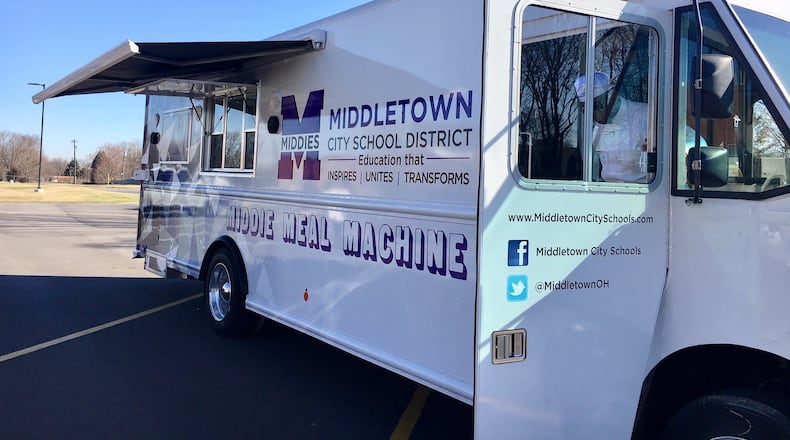Many area school districts are going to historic lengths to bring nutritional meals into the communities where some of their poorer students live.
Now that battle against hunger has gone mobile.
Last week saw Middletown City Schools unveil the district’s first food truck, part of a $225,000 program to feed the district’s needy students by going to them on non-school days. The large, brightly colored truck will travel to some of Middletown’s low-income communities this summer to deliver free lunches to children and teens who during the school year depend on such meals from their school cafeterias.
Hungry and malnourished students can’t pay attention as well, and over time they are prone to lagging behind developmentally and physically, studies have shown.
In Butler County, Middletown and New Miami Local Schools have 100 percent of its student population eligible for free school meals in 2018 with Hamilton City Schools showing 68 percent of its enrollment listed as poor enough to qualify, according to the Ohio Department of Education.
Credit: DaytonDailyNews
Among school systems in Butler and Warren counties, Mason City Schools has the lowest percentage of meal-eligible students at 9 percent.
Ohio is one of the most food insecure states in the nation, according to 2017 national report.
About 16 percent of Ohio households have low or very low food security, according to data published in September by the U.S. Department of Agriculture’s Economic Research Service.
Middletown joins Lakota Local Schools and Hamilton schools in using mobile units to transport meals where low-income students live during school breaks.
All Ohio school districts offer federally subsidized free and reduced cost meals to financial eligible students during the school year.
“The daily breakfast and lunch meals provided by Hamilton Schools may be the only complete and balanced meals some students receive in a day,” said Cinde Gorbandt, senior director of dining services.
“Due to family finances, or not having a parent at home to cook, many students may not have access to a hot meal while school is on break.”
Officials said the meal programs help students stay connected in the classroom.
“If a child is hungry, they are not going to feel ready to learn,” said Holli Morrish, spokeswoman for Talawanda Community Schools, which has about a third of its enrollment poor enough to qualify for free school meals.
Pam Pratt, spokeswoman for Edgewood City Schools — where in 2018, 36 percent of its enrollment could partake of free school meals — echoed that.
“Providing sufficient nutrition is so important for a student’s growth and development (and) when you reduce a child’s anxiety about basic necessities, such as where and when they will receive their next meal, they are able to focus on learning which influences the quality of their education,” Pratt said.
MORE: Hamilton Schools unveil district’s first food truck to feed needy students during summer break
In Butler County, nearly one in seven families are food insecure, meaning these families experience lack access, at times, to enough food, according to a 2017 report from the YMCA,.
Warren County’s Kings Local Schools is a longtime leader in making sure its students are fed over the weekends of a school year. The district, which reported 17 percent of its students eligible for free school meals in 2018, started a “power pack” food stuff program in 2010 that has since been adopted by many other area school systems.
Each school week, volunteer high school students pack nutritional meals, snacks and beverages for distribution to low-income students on Fridays to last them through the weekend.
The food bags are then delivered to students’ lockers during Friday classes, when the hallways are empty, so those students don’t draw attention. Or they are dropped off at the front of closed classroom doors so teachers can quietly hand them to students before they leave for home.
“Food insecurity puts tremendous stress on families, so we do our best to identify students who may be well-fed during the week at school, but the weekends can prove particularly daunting,” said Kings spokeswoman Dawn Gould.
“The Kings district is very aware that hunger negatively impacts a student’s academic performance. “We do our best to ensure that the process is equitable.”
Meal distribution through deliveries is the goal of Lakota’s mobile lunch program during summer break. Lakota officials map communities with the largest groupings of low-income households.
“Last year, we averaged 273 meals per day for a total of 13,320 meals over a 50-day period during summer break,” said Betsy Fuller, spokeswoman for Lakota.
Middletown’s new food truck, adorned with “Middie Meal Machine” and the district’s logo purple represents the latest reform tried by the largely low-income school districts.
“We are so excited the Middie Meal Machine is finally here,” said Middletown Schools Superintendent Marlon Styles Jr.
“We’ve been modernizing our approach to reaching students and teaching healthy habits. The Middie Meal Machine showcases the district’s commitment to provide all students with what they need to be successful.”
WHAT IS FOOD SECURITY?
According to the United States Department of Agriculture the definitions of food security are two-fold:
Low food security: Reports of reduced quality, variety, or desirability of diet. Little or no indication of reduced food intake.
Very low food security: Reports of multiple indications of disrupted eating patterns and reduced food intake.
About the Author
